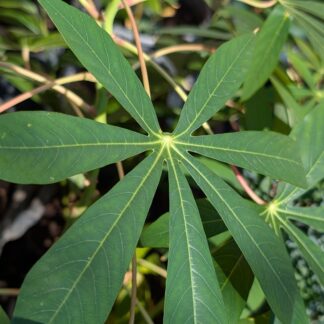Description
Cassava (Manihot esculenta), also known as yuca or manioc, is a hardy, tropical root crop cultivated primarily for its starchy tubers. Native to South America, it thrives in hot, sunny conditions with well-drained soils and can tolerate poor fertility and drought, making it a reliable food source in a range of climates. In Australia, cassava is grown in tropical and subtropical regions, where it can be integrated into home gardens, food forests, and permaculture systems.
Cassava plants form tall, shrub-like growth up to 2–3 metres high, with distinctive lobed leaves that are also edible when properly cooked. There are two main types of cassava: “sweet” varieties, which contain lower levels of naturally occurring cyanogenic compounds and require simple cooking, and “bitter” varieties, which contain higher levels and must be processed carefully (through soaking, grating, fermenting, and thorough cooking) to remove toxins. Both types provide a highly calorie-dense, gluten-free source of carbohydrates.
In traditional medicine, cassava leaves have been used anecdotally to support blood health and nutrition due to their rich iron and protein content, although they must always be cooked before consumption to remove harmful compounds. Cassava is also used in sustainable gardening as a fast biomass producer, suitable for chop-and-drop mulching, soil improvement, and as a living barrier or windbreak.
Care must be taken to properly identify and process cassava varieties before consumption, particularly when working with bitter types, to ensure food safety.



Reviews
There are no reviews yet.